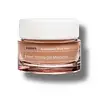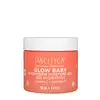What's inside
What's inside
 Key Ingredients
Key Ingredients

 Benefits
Benefits

 Concerns
Concerns

 Ingredients Side-by-side
Ingredients Side-by-side

Water
Skin ConditioningGlycerin
HumectantPropanediol
SolventCaprylic/Capric/Myristic/Stearic Triglyceride
EmollientCoco-Caprylate
EmollientImperata Cylindrica Root Extract
Skin ConditioningSodium Acrylates Copolymer
C13-15 Alkane
SolventHydrogenated Ethylhexyl Olivate
EmollientAcrylates/C10-30 Alkyl Acrylate Crosspolymer
Emulsion StabilisingAlgin
MaskingAscorbyl Palmitate
AntioxidantAscorbyl Tetraisopalmitate
AntioxidantBehenyl Alcohol
EmollientCaprylyl Glycol
EmollientCarbomer
Emulsion StabilisingCellulose Gum
Emulsion StabilisingCetearyl Alcohol
EmollientChamomilla Recutita Flower Extract
MaskingCitric Acid
BufferingDictyopteris Polypodioides Extract
EmollientDisodium Phosphate
BufferingGlyceryl Acrylate/Acrylic Acid Copolymer
HumectantGlyceryl Caprylate
EmollientGlyceryl Polyacrylate
Glyceryl Stearate Citrate
EmollientHelianthus Annuus Seed Oil
EmollientHydrogenated Olive Oil Unsaponifiables
EmollientHydrolyzed Sodium Hyaluronate
Skin ConditioningLactic Acid
BufferingLecithin
EmollientLevulinic Acid
PerfumingMica
Cosmetic ColorantMicrocrystalline Cellulose
AbsorbentPancratium Maritimum Extract
BleachingPanthenol
Skin ConditioningPentylene Glycol
Skin ConditioningPolyacrylate Crosspolymer-6
Emulsion StabilisingPotassium Phosphate
BufferingPullulan
Rosa Canina Fruit Extract
AstringentRosa Canina Fruit Oil
EmollientRosmarinus Officinalis Extract
AntimicrobialSerine
MaskingSodium Hyaluronate
HumectantSodium Levulinate
Skin ConditioningSqualane
EmollientSynthetic Fluorphlogopite
Terminalia Ferdinandiana Fruit Extract
AntioxidantTetrasodium Glutamate Diacetate
Tin Oxide
AbrasiveTocopherol
AntioxidantTocopheryl Acetate
AntioxidantTrehalose
HumectantUrea
BufferingXanthan Gum
EmulsifyingCI 77491
Cosmetic ColorantCI 77499
Cosmetic ColorantCI 77891
Cosmetic ColorantBenzyl Alcohol
PerfumingPhenoxyethanol
PreservativeSodium Benzoate
MaskingParfum
MaskingAlcohol Denat.
AntimicrobialWater, Glycerin, Propanediol, Caprylic/Capric/Myristic/Stearic Triglyceride, Coco-Caprylate, Imperata Cylindrica Root Extract, Sodium Acrylates Copolymer, C13-15 Alkane, Hydrogenated Ethylhexyl Olivate, Acrylates/C10-30 Alkyl Acrylate Crosspolymer, Algin, Ascorbyl Palmitate, Ascorbyl Tetraisopalmitate, Behenyl Alcohol, Caprylyl Glycol, Carbomer, Cellulose Gum, Cetearyl Alcohol, Chamomilla Recutita Flower Extract, Citric Acid, Dictyopteris Polypodioides Extract, Disodium Phosphate, Glyceryl Acrylate/Acrylic Acid Copolymer, Glyceryl Caprylate, Glyceryl Polyacrylate, Glyceryl Stearate Citrate, Helianthus Annuus Seed Oil, Hydrogenated Olive Oil Unsaponifiables, Hydrolyzed Sodium Hyaluronate, Lactic Acid, Lecithin, Levulinic Acid, Mica, Microcrystalline Cellulose, Pancratium Maritimum Extract, Panthenol, Pentylene Glycol, Polyacrylate Crosspolymer-6, Potassium Phosphate, Pullulan, Rosa Canina Fruit Extract, Rosa Canina Fruit Oil, Rosmarinus Officinalis Extract, Serine, Sodium Hyaluronate, Sodium Levulinate, Squalane, Synthetic Fluorphlogopite, Terminalia Ferdinandiana Fruit Extract, Tetrasodium Glutamate Diacetate, Tin Oxide, Tocopherol, Tocopheryl Acetate, Trehalose, Urea, Xanthan Gum, CI 77491, CI 77499, CI 77891, Benzyl Alcohol, Phenoxyethanol, Sodium Benzoate, Parfum, Alcohol Denat.
Water
Skin ConditioningGlycerin
HumectantBeta-Glucan
Skin ConditioningAlgin
MaskingXanthan Gum
EmulsifyingHydrolyzed Jojoba Esters
Skin ConditioningCetearyl Olivate
Sorbitan Olivate
EmulsifyingCoconut Alkanes
EmollientCoco-Caprylate/Caprate
EmollientDiheptyl Succinate
EmollientCapryloyl Glycerin
Glycol/Sebacic Acid Copolymer
AbrasiveBiosaccharide Gum-1
HumectantCeramide AP
Skin Conditioning1,2-Hexanediol
Skin ConditioningArginine
MaskingAloe Barbadensis Leaf Juice
Skin ConditioningTetrahexyldecyl Ascorbate
AntioxidantVitis Vinifera Juice
AntioxidantCucurbita Pepo Seed Oil
EmollientBisabolol
MaskingTocopherol
AntioxidantBoswellia Serrata Resin Extract
SmoothingTerminalia Ferdinandiana Fruit Extract
AntioxidantAscorbic Acid
AntioxidantNiacinamide
SmoothingEthylhexylglycerin
Skin ConditioningHydroxyethylcellulose
Emulsion StabilisingGluconolactone
Skin ConditioningSodium Benzoate
MaskingParfum
MaskingWater, Glycerin, Beta-Glucan, Algin, Xanthan Gum, Hydrolyzed Jojoba Esters, Cetearyl Olivate, Sorbitan Olivate, Coconut Alkanes, Coco-Caprylate/Caprate, Diheptyl Succinate, Capryloyl Glycerin, Glycol/Sebacic Acid Copolymer, Biosaccharide Gum-1, Ceramide AP, 1,2-Hexanediol, Arginine, Aloe Barbadensis Leaf Juice, Tetrahexyldecyl Ascorbate, Vitis Vinifera Juice, Cucurbita Pepo Seed Oil, Bisabolol, Tocopherol, Boswellia Serrata Resin Extract, Terminalia Ferdinandiana Fruit Extract, Ascorbic Acid, Niacinamide, Ethylhexylglycerin, Hydroxyethylcellulose, Gluconolactone, Sodium Benzoate, Parfum
 Reviews
Reviews

Ingredients Explained
These ingredients are found in both products.
Ingredients higher up in an ingredient list are typically present in a larger amount.
Algin is brown algae. Algae is an informal term for a group of aquatic organisms that can photosynthesize. It is estimated there are at least 30,000 types of Algae.
Algae contains antioxidants. Antioxidants help fight free-radicals. Free-radicals are molecules that may damage your skin cells, such as pollution.
Glycerin is already naturally found in your skin. It helps moisturize and protect your skin.
A study from 2016 found glycerin to be more effective as a humectant than AHAs and hyaluronic acid.
As a humectant, it helps the skin stay hydrated by pulling moisture to your skin. The low molecular weight of glycerin allows it to pull moisture into the deeper layers of your skin.
Hydrated skin improves your skin barrier; Your skin barrier helps protect against irritants and bacteria.
Glycerin has also been found to have antimicrobial and antiviral properties. Due to these properties, glycerin is often used in wound and burn treatments.
In cosmetics, glycerin is usually derived from plants such as soybean or palm. However, it can also be sourced from animals, such as tallow or animal fat.
This ingredient is organic, colorless, odorless, and non-toxic.
Glycerin is the name for this ingredient in American English. British English uses Glycerol/Glycerine.
Learn more about GlycerinParfum is a catch-all term for an ingredient or more that is used to give a scent to products.
Also called "fragrance", this ingredient can be a blend of hundreds of chemicals or plant oils. This means every product with "fragrance" or "parfum" in the ingredients list is a different mixture.
For instance, Habanolide is a proprietary trade name for a specific aroma chemical. When used as a fragrance ingredient in cosmetics, most aroma chemicals fall under the broad labeling category of “FRAGRANCE” or “PARFUM” according to EU and US regulations.
The term 'parfum' or 'fragrance' is not regulated in many countries. In many cases, it is up to the brand to define this term.
For instance, many brands choose to label themselves as "fragrance-free" because they are not using synthetic fragrances. However, their products may still contain ingredients such as essential oils that are considered a fragrance by INCI standards.
One example is Calendula flower extract. Calendula is an essential oil that still imparts a scent or 'fragrance'.
Depending on the blend, the ingredients in the mixture can cause allergies and sensitivities on the skin. Some ingredients that are known EU allergens include linalool and citronellol.
Parfum can also be used to mask or cover an unpleasant scent.
The bottom line is: not all fragrances/parfum/ingredients are created equally. If you are worried about fragrances, we recommend taking a closer look at an ingredient. And of course, we always recommend speaking with a professional.
Learn more about ParfumSodium Benzoate is a preservative. It's used in both cosmetic and food products to inhibit the growth of mold and bacteria. It is typically produced synthetically.
Both the US FDA and EU Health Committee have approved the use of sodium benzoate. In the US, levels of 0.1% (of the total product) are allowed.
Sodium benzoate works as a preservative by inhibiting the growth of bacteria inside of cells. It prevents the cell from fermenting a type of sugar using an enzyme called phosphofructokinase.
It is the salt of benzoic acid. Foods containing sodium benzoate include soda, salad dressings, condiments, fruit juices, wines, and snack foods.
Studies for using ascorbic acid and sodium benzoate in cosmetics are lacking, especially in skincare routines with multiple steps.
We always recommend speaking with a professional, such as a dermatologist, if you have any concerns.
Learn more about Sodium BenzoateTerminalia Ferdinandiana Fruit Extract is from the Kakadu plum. The Kakadu plum is native to northern Australia. The Kakadu plum holds the record for having the highest amount of natural vitamin C.
This ingredient is an antioxidant. Antioxidants help fight free-radical molecules. Free-radical molecules are capable of damaging our cells and other genetic material. Antioxidants help stabilize free-radicals and thus may reduce the signs of aging.
The high vitamin C content of Kakadu plum also helps lighten skin. Vitamin C has been shown to block the process of skin darkening that leads to hyperpigmentation.
Kakadu plums have been used by indigenous cultures as medicine to help treat colds and as an antiseptic.
Learn more about Terminalia Ferdinandiana Fruit ExtractTocopherol (also known as Vitamin E) is a common antioxidant used to help protect the skin from free-radicals and strengthen the skin barrier. It's also fat soluble - this means our skin is great at absorbing it.
Vitamin E also helps keep your natural skin lipids healthy. Your lipid skin barrier naturally consists of lipids, ceramides, and fatty acids. Vitamin E offers extra protection for your skin’s lipid barrier, keeping your skin healthy and nourished.
Another benefit is a bit of UV protection. Vitamin E helps reduce the damage caused by UVB rays. (It should not replace your sunscreen). Combining it with Vitamin C can decrease sunburned cells and hyperpigmentation after UV exposure.
You might have noticed Vitamin E + C often paired together. This is because it is great at stabilizing Vitamin C. Using the two together helps increase the effectiveness of both ingredients.
There are often claims that Vitamin E can reduce/prevent scarring, but these claims haven't been confirmed by scientific research.
Learn more about TocopherolWater. It's the most common cosmetic ingredient of all. You'll usually see it at the top of ingredient lists, meaning that it makes up the largest part of the product.
So why is it so popular? Water most often acts as a solvent - this means that it helps dissolve other ingredients into the formulation.
You'll also recognize water as that liquid we all need to stay alive. If you see this, drink a glass of water. Stay hydrated!
Learn more about WaterXanthan gum is used as a stabilizer and thickener within cosmetic products. It helps give products a sticky, thick feeling - preventing them from being too runny.
On the technical side of things, xanthan gum is a polysaccharide - a combination consisting of multiple sugar molecules bonded together.
Xanthan gum is a pretty common and great ingredient. It is a natural, non-toxic, non-irritating ingredient that is also commonly used in food products.
Learn more about Xanthan Gum